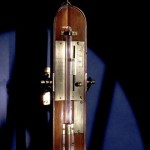In working on my book Evening Gray, Morning Red, I found myself using metaphors referencing barometers. “The glass was falling”, suggesting a storm, or a “rising glass” suggesting clear and dry weather, seemed perfectly apt language for a nautical novel. The problem was, the novel is set between 1768 and 1772. Were marine barometers common in the period? Did they even exist? I had some research to do.
The invention of the barometer is usually attributed to Torricelli in the mid-1600s, though the “weather glass” or “thunder glass”, a water barometer, is said to have been developed by Gheijsbrecht de Donckere in the 16th century. In England in 1695 Daniel Quare patented a marine barometer, which never seems to have caught on.
The first practical marine barometer appears to have been developed by an English optician and scientific instrument maker, Edward Nairne, around 1771 to 1772. He solved the problem of the mercury being disturbed by the ship’s motion by constricting the glass tube between the cistern and register plate. He also mounted the device on gimbals, to further dampen the motion. His barometer was carried by Captain Cook on his second voyage to the South Pacific.
So the answer to my question – was a marine barometer common in 1768, is no. On the other hand “thunder glasses” were brought over by the Pilgrims and were consulted by fishermen and sailors before leaving port, so a reference to a falling or rising glass might not be out of place in a colonial harbor.
Edward Nairne also developed another invaluable tool – the rubber eraser. Prior to his rubber eraser, breadcrumbs were used as erasers. As a young naval architect and fledgling draftsman I was taught that an eraser was a draftamn’s the most powerful tool. Probably applies to writers equally, as well.


I am keen to know the origin of the image you show of the Nairne barometer used by Captain Cook, and the present whereabouts of the instrument.
My recollection is that I grabbed it from the Wikipedia page for Edward Nairne. Checking now I see only an image of a telescope made by Naire but no barometer.
The original Cook barometer is at National Maritime Museum in Greenwich. Here is a photo and some background:
http://collections.rmg.co.uk/collections/objects/43017.html